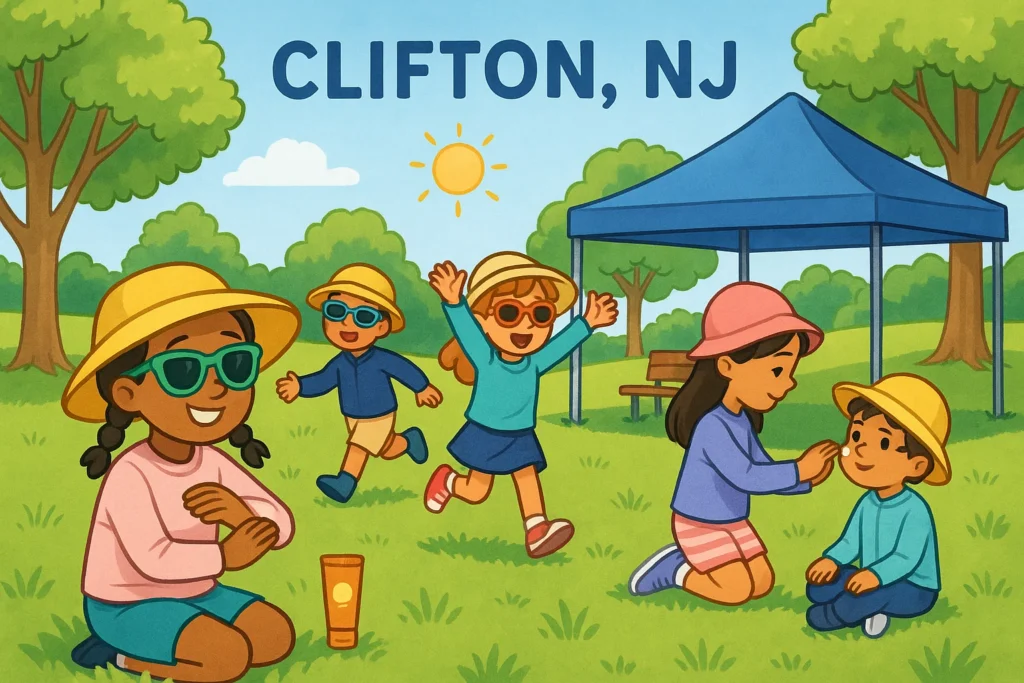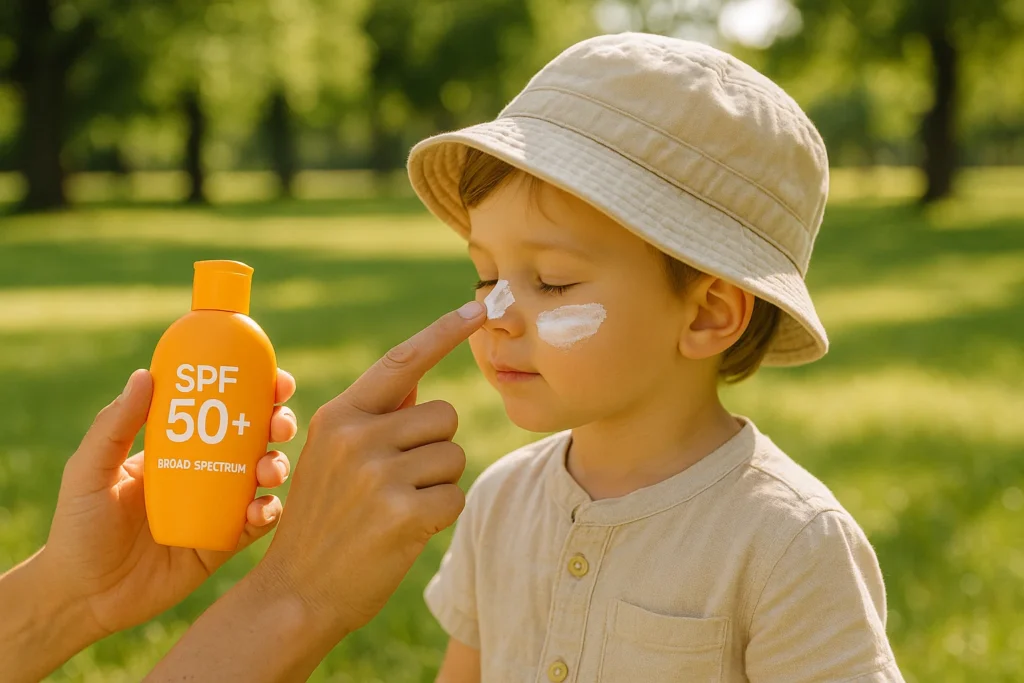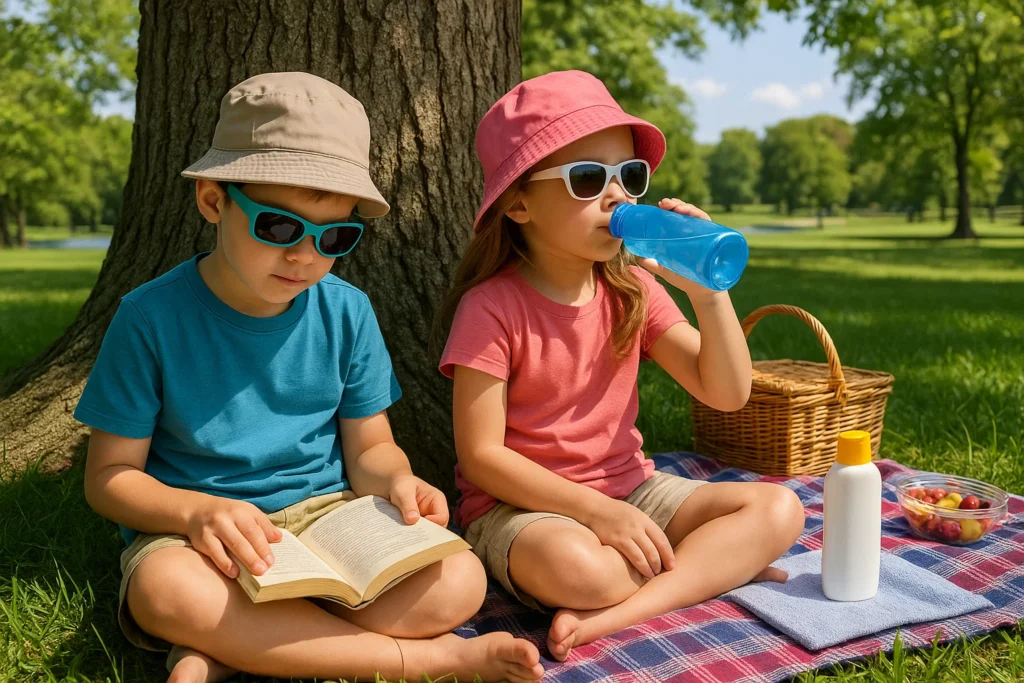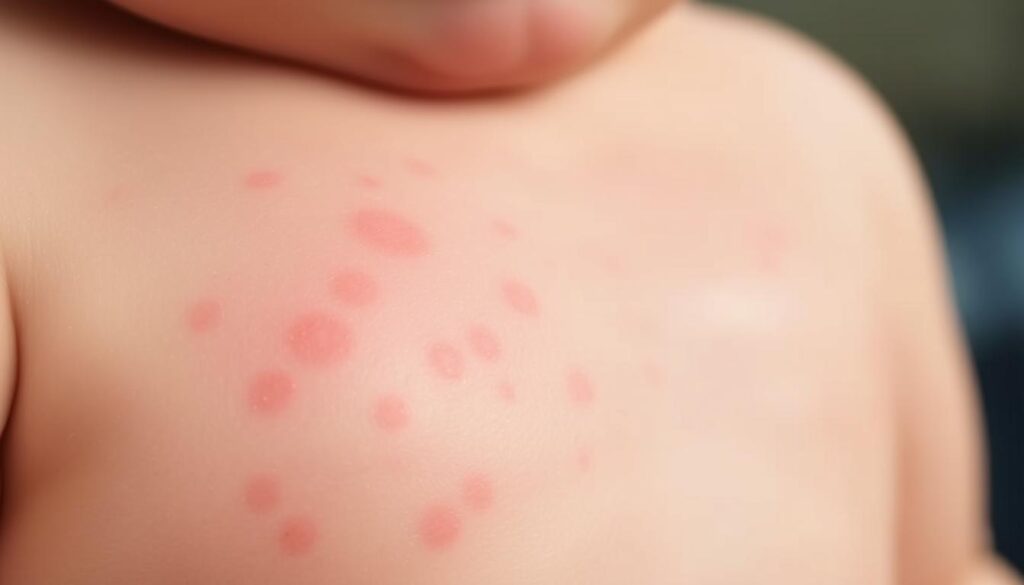As parents, we want our kids to enjoy the outdoors safely. Did you know skin damage from UV rays can start in childhood? So, You definitely need sun safety for kids. In Clifton, NJ, where summers are warm, keeping our kids safe from UV radiation is key.
The 5 S’s of sun protection are simple and effective. They help keep our children’s skin safe. These easy-to-remember steps make sun safety a daily habit when we go outside.

The Importance of Sun Safety for Kids in Clifton NJ
It’s vital to know the dangers of UV exposure to keep our kids safe outside. As parents, we must act to shield our children’s skin from the sun’s harmful rays.
The Impact of UV Exposure on Young Skin
Children’s skin is more vulnerable to UV damage because it’s thinner and has more water. Without proper protection, they can get sunburned, which raises their risk of skin cancer later. Using outdoor safety measures like staying in the shade and wearing protective clothes can help a lot.
Long-term Consequences of Childhood Sunburns
Sunburns in kids can lead to serious problems like melanoma and other skin cancers. It’s key to follow sun safety guidelines to avoid these issues. Teaching kids about sun protection helps them develop habits that last a lifetime.
Clifton’s Summer UV Index and What It Means
Clifton has a high UV index in the summer, so parents need to be extra careful. Using child-friendly sunscreen with a high SPF and applying it often is a simple yet effective way to prevent sunburn in kids. Knowing the UV index and taking the right steps helps parents let their kids enjoy the outdoors safely.
The 5 S’s of Sun Safety for Kids in Clifton
The 5 S’s of sun safety for kids offer a simple way for families in Clifton to stay safe. It helps parents and caregivers shield their kids from the sun’s harmful UV rays.
Overview of the Sun Safety Framework
The 5 S’s mean Slip on protective clothing, Slop on sunscreen, Slap on a hat, Seek shade, and Slide on sunglasses. Each step is key to protecting different body parts from UV rays.
Why the 5 S’s Work for Families in Clifton
The 5 S’s are great for Clifton families because they fit into many outdoor activities. Whether at Clifton’s parks or your backyard, these steps are easy to add to your day.
| Activity | Sun Safety Tips |
| Beach Trips | Slip on lightweight, UV-protective clothing; Slop on water-resistant sunscreen |
| Park Visits | Seek shade under trees or umbrellas; Slap on a hat for extra protection |
| Outdoor Sports | Slide on sunglasses with UV protection; Slip on moisture-wicking, UV-protective clothing |
Adapting Sun Safety for Local Activities
In Clifton, where the sun is strong in summer, it’s important to adjust sun safety for kids for local activities. For example, at outdoor festivals or sports, families can use the 5 S’s to keep kids safe.
By sticking to the 5 S’s, Clifton families can have fun outside while keeping their kids’ skin safe from the sun.
S1: Slip on Protective Clothing
The first ‘S’ of sun safety for kids is ‘Slip on protective clothing.’ This is key to keeping our kids safe from UV rays. When getting our kids ready for outdoor fun in Clifton, picking the right clothes is vital.
Choosing the Right UV-Protective Fabrics
Not all clothes protect from the sun equally. We need to find fabrics with a UPF (Ultraviolet Protection Factor) of 50+. This means only 1/50th of UV rays get through. UPF 50+ fabric is top-notch for sun protection. Cotton and linen are good, but synthetic fabrics made for UV protection are even better.
Dressing for Clifton’s Summer Climate
Clifton’s summer is hot and humid. So, it’s important to dress our kids in clothes that breathe and are light. For really hot days, we suggest:
Breathable Options for Hot Days
- Loose-fitting cotton shirts and shorts
- Lightweight, UPF-rated clothing
- Avoiding dark colors that absorb heat
Layering Strategies for Variable Weather
Even though it’s usually warm in Clifton in summer, rain or cooler evenings can happen. Wearing lightweight, UV-protective clothes that can be layered helps us adjust to the weather. For those interested in water activities, learning about Water Safety Tips for Kids in Clifton, NJ is equally important during summer months.
| Clothing Item | UV Protection | Breathability |
| UPF 50+ T-shirt | Excellent | High |
| Cotton Long-sleeve Shirt | Good | Medium |
| Synthetic UV-protective Pants | Excellent | High |
By picking the right clothes and watching the weather, we can make sure our kids have fun outside while staying safe from the sun.
S2: Slop on Sunscreen for Kids

The second ‘S’ in our sun safety for kids framework is about slopping on sunscreen. This simple act protects our kids’ skin from the sun’s harmful rays. Sunscreen blocks UV rays, preventing sunburn, premature aging, and skin cancer.
Selecting Broad-Spectrum Sunscreen for Children
Choosing the right sunscreen for our kids is key. We should pick a broad-spectrum option that blocks UVA and UVB rays. The American Academy of Pediatrics suggests an SPF of at least 30. For sensitive skin, choose fragrance-free and hypoallergenic sunscreens to avoid irritation.
Proper Application Techniques and Timing
Applying sunscreen correctly is as important as choosing the right one. Apply 15-30 minutes before going outside and reapply every two hours or after swimming or sweating. Remember to cover often-missed areas like the tops of ears, noses, and the backs of necks.
Step-by-Step Application Guide
- Choose a broad-spectrum sunscreen with SPF 30 or higher.
- Apply sunscreen 15-30 minutes before going outside.
- Use enough sunscreen to cover all exposed skin (about one ounce per application).
- Rub sunscreen thoroughly into the skin until it’s fully absorbed.
- Reapply every two hours or after swimming or sweating.
Sunscreen Options for Sensitive Skin
For kids with sensitive skin, there are gentle and effective sunscreens. Mineral sunscreens with zinc oxide or titanium dioxide are recommended. They provide a physical barrier against UV rays and are less likely to irritate the skin.
| Skin Type | Sunscreen Recommendation | Key Ingredients |
| Normal | Broad-spectrum chemical sunscreen | Avobenzone, Octinoxate |
| Sensitive | Mineral sunscreen | Zinc Oxide, Titanium Dioxide |
| Very Sensitive | Hypoallergenic, fragrance-free mineral sunscreen | Zinc Oxide, Titanium Dioxide |
By following these guidelines and choosing the right sunscreen, we can significantly reduce our kids’ risk of sunburn and long-term skin damage. This ensures they can enjoy the outdoors safely.
S3: Slap on a Hat
A hat is more than just a fashion statement for kids; it’s a key part of their sun safety for kids. When kids wear hats, they block harmful UV rays. This protects sensitive areas like the face, neck, and ears.
Best Hat Styles for Maximum Protection
Not all hats are the same when it comes to sun protection. We suggest hats with a wide brim of at least 3 inches for the best coverage. Some top picks include:
- Bucket hats
- Legionnaire hats
- Wide-brimmed sun hats
Making Hats Fun for Kids to Wear
To make hats fun for kids, we can:
- Let them pick their favorite hat style or color
- Play a game by wearing hats together as a family
- Use fun, kid-friendly language to explain why hats are important
Hat-Friendly Activities in Clifton Parks
Clifton parks are great for hat-wearing fun. Some activities include:
- Picnics under shaded areas
- Nature walks
- Outdoor games like tag or frisbee
S4: Seek Shade
Seeking shade is key in sun safety for kids. When outside, finding shade cuts down UV ray exposure. This is important, as UV rays can harm our skin.
Identifying Safe Shaded Areas in Clifton Parks
Clifton parks have great spots for shade. Look for areas with big trees, gazebos, or picnic shelters. These places are perfect for kids to play safely.
Creating Shade for Outdoor Activities
We can make shade for outdoor fun. Portable canopies, umbrellas, or sun shelters work well. They’re great for parties or family picnics. This way, kids stay safe even where there’s little natural shade.
Planning Around Peak Sun Hours
Peak sun hours are 10 AM to 4 PM. This is when the sun’s rays are strongest. Plan activities for early morning or late afternoon. This helps keep kids safe from the sun.
S5: Slide on Sunglasses

Protecting your child’s eyes from the sun’s harmful UV rays is key to sun safety for kids. Kids’ eyes are more at risk because their lenses let in more UV radiation.
Why Eye Protection Matters for Children
UV radiation can cause serious eye problems like cataracts and eye cancer. It can also lead to photokeratitis, a sunburn-like condition on the eye’s surface.
Choosing Kid-Friendly Sunglasses with UV Protection
Look for sunglasses that block 100% of UV rays. They should wrap around the eyes to block UV rays from the sides. Polarized lenses can also reduce glare, making them more comfy for kids.
| Feature | Benefit |
| 100% UV Protection | Protects eyes from harmful UV rays |
| Polarized Lenses | Reduces glare, enhances comfort |
| Wrap-around Style | Prevents UV rays from entering from the sides |
Making Sunglasses a Daily Habit
Let your child pick their own sunglasses. This can make them more excited to wear them. Make wearing sunglasses a regular part of their sun safety for kids routine.
New Jersey’s Sunscreen Law for Schools
New Jersey has made a big step to protect kids’ health with a new sunscreen law in schools. This law is part of a bigger effort to teach sun safety for kids and keep students safe from UV radiation.
Understanding P.L.2025, c.38 Requirements
The law, P.L.2025, c.38, says schools must let students use sunscreen during school hours. It’s to lower the chance of skin damage and skin cancer in kids by teaching them to protect themselves from the sun.
How Clifton Schools Are Implementing the Policy
Clifton schools are changing their health and safety rules to follow the new policy. They’re teaching staff and students why sun safety for kids is key and making sure kids can use sunscreen at school.
What Parents Need to Know About Sunscreen at School
Parents should know their kids can carry and use sunscreen at school. It’s a good idea for parents to give their kids sunscreen and teach them how to use it right.
Preparing Your Child for Self-Application
Teach your child how to put on sunscreen right, making sure to cover all skin that’s not covered. Tell them to put on more sunscreen every two hours or after they swim or sweat.
Age-Specific Sun Safety Guidelines
Sun safety for kids changes with age, from babies to teens. Knowing these changes helps us protect our kids from the sun.
Infants (0-6 months): Special Considerations
The American Academy of Pediatrics says no sunscreen for babies under six months. Instead, we should:
- Dress them in light, loose clothes that cover arms and legs
- Use a wide-brimmed hat for face and neck protection
- Keep them in the shade, mainly from 10 am to 4 pm
Toddlers and Preschoolers (1-5 years)
When kids get older, we can start using sunscreen. It’s important to:
- Use a broad-spectrum sunscreen with at least SPF 30
- Apply it 15-30 minutes before going outside
- Reapply every two hours or after swimming or sweating
We should also encourage them to play in shaded areas and wear protective clothes.
School-Age Children (6-12 years)
For school-age kids, we balance sun protection with their growing independence. Teaching them about sun safety for kids is key. This includes:
- Reminding them to apply sunscreen before going out
- Encouraging them to wear hats and sunglasses
- Planning outdoor activities around peak sun hours
During school preparations, it’s also important to schedule a Physical Exam for School in Clifton NJ to ensure overall health before the academic year begins.
Teenagers (13-18 years)
Teenagers spend more time outside, doing various activities. At this age, it’s vital to:
“Teach them that sun protection is a part of their daily routine, just like brushing their teeth or taking a shower.”
We should talk about the long-term benefits of sun safety for kids. This includes preventing early aging and skin cancer.
Recognizing and Treating Heat Rash in Babies
Summer fun can quickly turn to discomfort if your baby develops heat rash. As a parent, it’s essential to recognize the symptoms and know how to treat them effectively. Understanding Summer Rashes in Kids in Clifton, NJ can help parents identify various skin conditions that occur during warmer months.
Identifying Heat Rash Symptoms

Heat rash, also known as prickly heat, appears as small, red bumps or blisters on the skin. It usually shows up in areas where clothing fits tightly or where the skin folds. It’s important to spot these symptoms early to prevent further irritation.
Treatment for Heat Rash on Baby’s Face
For heat rash on your baby’s face, gently clean the area with cool water and a mild soap. Stay away from harsh products that can irritate the skin further. A cool compress or a fan can help lower the temperature and ease discomfort.
Treatment for Heat Rash on Baby’s Neck
For heat rash on the neck, keep the area cool and dry. Wear loose clothing to reduce irritation. You can also apply a calamine lotion or a hydrocortisone cream, but always check with your pediatrician first.
Distinguishing Heat Rash from Allergic Reactions
It can be hard to tell the difference between heat rash and allergic reactions. Heat rash usually appears in clusters and is in specific areas. Allergic reactions can spread more widely. If you’re unsure, it’s best to talk to a pediatrician.
When to Consult a Pediatrician
If your baby’s heat rash doesn’t get better, gets worse, or comes with a fever, see a pediatrician. They can guide you on the best treatment and check for other conditions that might need medical care.
By recognizing the signs of heat rash and knowing how to treat it, you can help your baby stay comfortable and enjoy the summer months.
Creating Sun-Safe Routines for Clifton Families
Creating sun-safe routines is key to protecting kids from sun-related health issues in Clifton. Simple habits can make outdoor fun safe for everyone’s skin.
Daily Sun Protection Habits
It’s important to make sun protection a daily habit. Start by applying sunscreen every morning, even on cloudy days. Choose a broad-spectrum sunscreen with a high SPF for the best protection.
Also, make wearing hats a daily routine, not just for outdoor play. Hats protect the face, neck, and ears. Plus, they add a fun touch to kids’ outfits.
Seasonal Adjustments for Year-Round Protection
Clifton’s summer sun is intense, but sun safety for kids is needed all year. Snow in winter can also increase UV exposure. So, keep up with sun protection all year.
| Season | Sun Safety Tips |
| Summer | Use high SPF sunscreen, wear protective clothing, and seek shade during peak sun hours. |
| Winter | Protect skin from snow reflection, use lip balm with SPF, and wear sunglasses. |
| Spring/Autumn | Continue using sunscreen, adjust outdoor activities according to UV index forecasts. |
Making Sun Safety Fun and Engaging for Kids
Make sun safety fun for kids. Turn it into a game or activity. Create a sun safety checklist for them to follow. It’s a great way to teach them.
Local Resources for Sun-Safe Activities
Clifton has many parks and shaded areas for safe outdoor fun. Use these spots to practice sun safety for kids. Some top places include:
- Clifton Park
- Weasel Brook Park
- Hamilton House Historic Site and Museum
By using these local spots and sticking to sun-safe routines, Clifton families can have a healthier, safer time outdoors.
How Fayrouz Pediatrics Supports Your Child’s Skin Health
Fayrouz Pediatrics focuses on keeping your child’s skin safe. We know how important it is to protect their skin from the sun. This is key for their health. Finding a trusted pediatrician near me ensures your child receives comprehensive care for all health concerns.
Our Specialized Services for Sun-Related Concerns
Our team at Fayrouz Pediatrics has services for sun issues. We give you pediatric sun safety tips to protect your child’s skin.
Preventative Care and Education
Preventative care is our main focus. We teach parents about children’s skin health and sun protection. We want to give you the tools to keep your child’s skin safe. Our practice also offers comprehensive annual wellness checks for children to monitor overall health and development throughout the year.
Treatment Options for Sun Damage and Heat-Related Conditions
If your child gets sun damage or heat-related issues, we have solutions. Our sun damage treatment and heat-related condition treatment are effective. Our pediatricians work hard to care for your child.
At Fayrouz Pediatrics, we’re all about your child’s skin health. We offer care and education to help. Trust us to support your child’s well-being. For modern healthcare solutions, we also provide virtual pediatrics telemedicine services for convenient consultations when you can’t visit our office in person.
Protecting our children’s skin from the sun is a big job. We’ve learned about the 5 S’s of sun safety for kids in Clifton. It’s important to understand sun safety, take protective steps, and work with healthcare providers like Fayrouz Pediatrics.
Sun safety in Clifton is a team effort. Parents, caregivers, and doctors must all play a part. By choosing the right clothes, using sunscreen, wearing hats, staying in the shade, and using sunglasses, we can keep our kids safe outside.
At Fayrouz Pediatrics, we’re dedicated to helping your child stay safe from the sun. We offer care, education, and treatment for sun-related issues. By teaming up with us, you can trust that your child’s sun protection is in good hands. Let’s all work together to keep our children’s skin safe and promote sun safety in Clifton.
Contact us
- Address: 1135 Main Ave, Clifton, NJ 07011, United States
- Phone Number: (973) 928-3388
FAQ
What are the 5 S’s of sun safety for kids?
The 5 S’s are simple steps to keep kids safe from the sun. They include: Slip on protective clothing, Slop on sunscreen, Slap on a hat, Seek shade, and Slide on sunglasses. These steps help protect our kids from harmful UV rays.
How can we protect our baby’s sensitive skin from the sun?
To protect our baby’s skin, we keep them in the shade. We dress them in lightweight, loose clothes that cover their skin. We also use a broad-spectrum sunscreen with at least SPF 30 on exposed areas.
We advise parents to be careful with sunscreen on babies under six months. It’s best to consult with a pediatrician.
What type of sunscreen is best for children with sensitive skin?
For sensitive skin, we choose a broad-spectrum sunscreen that’s hypoallergenic or fragrance-free. These are less likely to irritate. We look for sunscreens designed for kids with sensitive skin and contain zinc oxide or titanium dioxide.
How often should we reapply sunscreen on our kids?
We should reapply sunscreen every two hours or after swimming or sweating. This keeps our kids protected from UV rays all day.
Can our kids wear sunglasses even if they don’t need vision correction?
Yes, sunglasses are key for sun safety, even without vision correction. They protect eyes and skin from harmful rays.
How can we make sun safety a fun and engaging experience for our kids?
We make sun safety fun by letting kids pick out their own sunscreen or sunglasses. We also choose fun hats together. Shade-seeking becomes a game by finding cool places to play.
What are the signs of heat rash in babies, and how can we treat it?
Heat rash looks like small, red bumps on a baby’s skin, often where clothes are tight. We treat it by keeping the area cool and dry. We dress our baby in lightweight clothes and avoid irritation. For severe cases, we might use a cool compress or see a pediatrician.